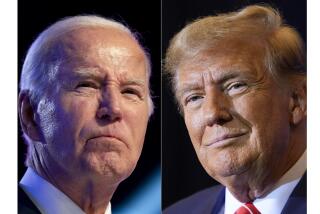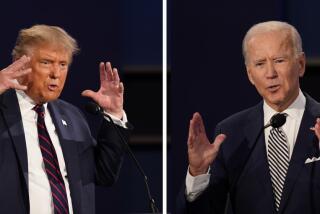Analysis: New poll analysis finds a wasted summer for Donald Trump and a boost for Hillary Clinton
The last six weeks have been a time of tumult in the presidential campaign — two conventions and a fistful of controversies, many of them created by Republican nominee Donald Trump himself.
With the campaign moving toward a final general election sprint, Trump finds himself in a dangerous place. He has narrowed his support to a segment of the electorate, and curbed his own momentum, according to an analysis of six weeks of findings in the USC Dornsife/Los Angeles Times Daybreak presidential tracking poll.
Over the same period, Democratic nominee Hillary Clinton has built support — even among groups previously arrayed against her — into demonstrable advantages.
The poll was first published July 10 and is in its seventh week. The analysis covered the six full weeks, and thus did not chart any impact from Trump’s high-profile speeches this week, or his midweek decision to shake up his campaign’s leadership.
Over six weeks’ time, Trump’s 22-point lead among whites narrowed to 18 points. Among nonwhites, Clinton’s advantage rose from 38 points to 46 points.
Trump’s lead among voters without a college degree shrank from 12 points to five points. Among those with college degrees, Clinton’s edge increased from 13 points to 15 points.
Among men, Trump’s advantage dropped from 12 points to eight points. Among women, Clinton’s edge grew from five points to 12 points.
The USC Dornsife/L.A. Times tracking poll, a running seven-day tally, measures voter support differently than most election surveys, using a panel of roughly 3,200 eligible voters whose numbers are representative of the overall electorate. The panel is surveyed continuously, so the results mainly reflect changes in the minds of the same large group, rather than variations between different samples as would occur in a more conventional survey.
The tracking poll also takes into account the firmness of voter support in a way that is different from other surveys — and which, to this point, is reflected in the narrower edge Clinton has over Trump in this poll compared with her lead in most others.
Over the six weeks, few of the poll’s movements were dramatic, but the direction was consistent — to the advantage of Democrat Clinton and against Republican Trump. Emblematic of that was the shift in who’s leading: Trump initially led by three points; six weeks in, Clinton has a narrow edge.
The changes confirmed long-held dynamics in the race: Blue-collar Americans are more supportive of Trump, responding to his castigations of trade deals and the rocky economic recovery, as well as his denunciation of politics as usual.
Women, minorities and more educated voters, meanwhile, have been more likely to side with Clinton and against Trump, in some part because of the rhetoric he has used through the campaign.
The choice?
“What bothers you more, an economy that has left you marginalized or a presidential candidate who has left you diminished and demonized?” said Dan Schnur, director of USC’s Jesse M. Unruh Institute of Politics.
“This is the politics of resentment in action. The only question is what you resent more.”
One of the most durable dividing lines in the campaign has been education. Trump retains control of two overlapping slices of the electorate, men without college degrees and white voters without college degrees, but his standing has stalled with both groups.
On July 10, the first week of the poll, Trump held an 18-point lead over Clinton among men lacking a college degree; by Week 6, his lead had shrunk somewhat to 14 points. That was roughly equivalent to the four-point drop among men overall.
But race played an undeniable role as well.
Among whites with no degree, Trump’s margin dropped from 35 points to 32 points over the six weeks. But among minorities in the same educational circumstances, Clinton’s already strong support increased to a margin of 44 points over Trump.
The move to 67% support for Clinton marked the largest jump — 10 percentage points — that was measured in the categories mingling race, gender and education level.
Trump averaged only a quarter of a point of improvement over eight categories. He was up in three of them — albeit by smaller increases than Clinton’s gains — down in three others and tied in one.
Clinton’s average improvement among eight categories was a far more substantial 4.5 points. She improved in seven of the eight categories and kept her support stable in the eighth.
Clinton’s pillars of support — women and minorities — are as important to her now as they were in the primary season, when they drove her to victory over Vermont Sen. Bernie Sanders.
Among both groups, support of Clinton defied any division by education, except when it came to the size of her advantage.
Women without college degrees went from favoring Trump to narrowly backing Clinton over the six-week period. Among women with college degrees, Clinton extended her already-sizable lead from 27 points to 31 points.
Her advantage among minority voters without college degrees rose from 32 points to 44 points during the six weeks. Among minority voters with degrees, the margin stayed consistent — but it was consistently huge, at 51 points both when the survey began and afterward, despite some convention-period gyrations.
That spoke to what is perhaps Trump’s biggest problem. As political campaigns wear on, voters tend to dig in their heels; there are fewer each week who have not decided on a candidate or are willing to drop their first choice for a second.
By his actions, Trump has crafted the narrowest of paths, maintaining the loyalty of white voters, particularly men, and hoping he has not driven off the women and minorities who will determine the election.
Twitter: @cathleendecker
ALSO
“Second Amendment people”: another diversion for Trump as voters make their decision
In complicated Ohio, Trump and Clinton trade voters as they vie for a key state
Updates on California politics
Live coverage from the campaign trail
More to Read
Get the L.A. Times Politics newsletter
Deeply reported insights into legislation, politics and policy from Sacramento, Washington and beyond. In your inbox three times per week.
You may occasionally receive promotional content from the Los Angeles Times.







